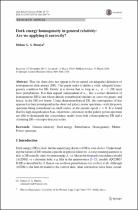Dark energy homogeneity in general relativity: Are we applying it correctly?
| dc.contributor.author | Duniya, Didam G. A. | |
| dc.date.accessioned | 2023-03-08T12:21:37Z | |
| dc.date.available | 2023-03-08T12:21:37Z | |
| dc.date.issued | 2016 | |
| dc.identifier.citation | Duniya, D. G. A. (2016). Dark energy homogeneity in general relativity: Are we applying it correctly?. General Relativity and Gravitation, 48 (4). https://doi.org/10.1007/s10714-016-2047-0 | en_US |
| dc.identifier.issn | 1572-9532 | |
| dc.identifier.uri | https://doi.org/10.1007/s10714-016-2047-0 | |
| dc.identifier.uri | http://hdl.handle.net/10566/8555 | |
| dc.description.abstract | Thus far, there does not appear to be an agreed (or adequate) definition of homogeneous dark energy (DE). This paper seeks to define a valid, adequate homogeneity condition for DE. Firstly, it is shown that as long as wx = −1, DE must have perturbations. It is then argued, independent of wx , that a correct definition of homogeneous DE is one whose density perturbation vanishes in comoving gauge: and hence, in the DE rest frame. Using phenomenological DE, the consequence of this approach is then investigated in the observed galaxy power spectrum—with the power spectrum being normalized on small scales, at the present epoch z = 0. It is found that for high magnification bias, relativistic corrections in the galaxy power spectrum are able to distinguish the concordance model from both a homogeneous DE and a clustering DE—on super-horizon scales. | en_US |
| dc.language.iso | en | en_US |
| dc.publisher | Springer | en_US |
| dc.subject | Dark energy | en_US |
| dc.subject | Perturbation | en_US |
| dc.subject | Homogeneity | en_US |
| dc.subject | Physics | en_US |
| dc.subject | Astronomy | en_US |
| dc.title | Dark energy homogeneity in general relativity: Are we applying it correctly? | en_US |
| dc.type | Article | en_US |

